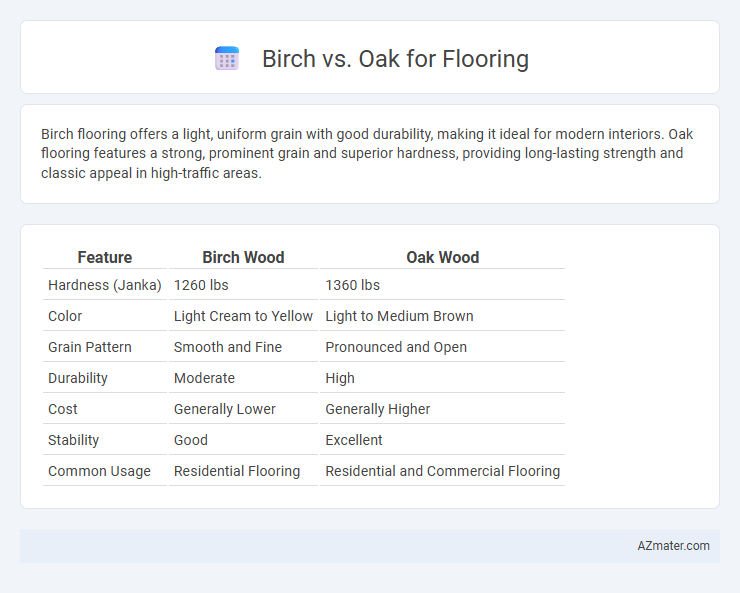Birch flooring offers a light, uniform grain with good durability, making it ideal for modern interiors. Oak flooring features a strong, prominent grain and superior hardness, providing long-lasting strength and classic appeal in high-traffic areas.
Table of Comparison
| Feature | Birch Wood | Oak Wood |
|---|---|---|
| Hardness (Janka) | 1260 lbs | 1360 lbs |
| Color | Light Cream to Yellow | Light to Medium Brown |
| Grain Pattern | Smooth and Fine | Pronounced and Open |
| Durability | Moderate | High |
| Cost | Generally Lower | Generally Higher |
| Stability | Good | Excellent |
| Common Usage | Residential Flooring | Residential and Commercial Flooring |
Introduction to Birch and Oak Flooring
Birch flooring offers a fine, even grain with a light color tone, making it ideal for contemporary interior designs that favor brightness and subtle texture. Oak flooring is renowned for its durability and characteristic grain patterns, available in red and white varieties that provide rich, warm hues suitable for rustic and traditional spaces. Both hardwood choices deliver strong performance, but birch's consistent appearance contrasts with oak's distinct, pronounced grain, influencing aesthetic selection.
Birch vs Oak: Appearance and Grain Patterns
Birch flooring features a smooth, consistent grain with subtle swirling patterns and a lighter color palette that ranges from creamy white to pale yellow, providing a clean, modern aesthetic. Oak flooring is renowned for its prominent, varied grain patterns with distinct rays and knots, offering a rich texture and warm hues from light brown to deep reddish tones. The more uniform grain of birch appeals to those seeking a minimalist look, while oak's dynamic patterns suit traditional or rustic interiors.
Durability and Hardness Comparison
Birch flooring offers a Janka hardness rating around 1260, making it moderately durable and resistant to dents, while oak flooring, particularly red oak, has a higher Janka hardness of approximately 1290, and white oak ranks even harder at about 1360, providing superior durability. Oak's denser grain structure enhances its resistance to wear and tear, making it ideal for high-traffic areas compared to birch's slightly softer composition. Both species are suitable for residential use, but oak's greater hardness ensures longer-lasting performance in demanding environments.
Color Variations and Styling Options
Birch flooring offers a light, creamy color palette with subtle reddish undertones, making it ideal for modern and Scandinavian-style interiors that emphasize brightness and simplicity. Oak flooring provides a broader range of color variations, from light golden hues to deep amber and rich brown tones, allowing for versatile styling options that complement traditional, rustic, and contemporary designs. Both woods can be stained or finished to enhance grain patterns, with oak's pronounced grain offering a textured, classic look while birch's smoother grain supports a clean, minimalist aesthetic.
Birch vs Oak: Cost and Affordability
Birch flooring generally costs less than oak, making it a more affordable option for budget-conscious homeowners. Oak is typically priced higher due to its durability and widespread popularity in hardwood flooring. The price difference between birch and oak can range from 10% to 30%, depending on grade and finish.
Installation Differences
Birch flooring is generally softer and more pliable, making it easier to cut and fit during installation, which suits DIY projects and intricate patterns. Oak, being denser and harder, requires more precise tools and expertise for cutting and nailing, often demanding professional installation for optimal results. The moisture content and expansion rate of oak necessitate careful acclimation before installation to prevent warping, while birch is less sensitive to humidity changes.
Maintenance and Care Requirements
Birch flooring requires regular cleaning and occasional resealing to maintain its smooth, light-toned surface, with moderate susceptibility to dents and scratches compared to harder woods. Oak flooring offers greater durability and resistance to wear due to its higher Janka hardness rating, making it easier to maintain in high-traffic areas with periodic refinishing. Both woods benefit from using gentle cleaning products and protecting against moisture, but oak typically demands less frequent maintenance to preserve its robust grain and color.
Environmental Impact and Sustainability
Birch flooring is generally more sustainable due to its faster growth rate and widespread availability compared to oak, which grows slower and requires longer harvesting cycles. Oak, while durable and strong, often comes from older, slower-growing trees that contribute more significantly to deforestation and habitat disruption. Choosing sustainably sourced birch can reduce environmental impact by supporting quicker forest regeneration and lowering carbon emissions associated with logging and transportation.
Best Applications: Where Each Wood Excels
Birch flooring excels in interior spaces that require durability combined with a light, modern aesthetic, making it ideal for living rooms, bedrooms, and kitchens with moderate foot traffic. Oak flooring is best suited for high-traffic areas such as hallways and commercial spaces due to its exceptional hardness and resistance to wear and dents. Both woods perform well with various finishes, but oak's natural grain and robustness make it preferred for traditional or rustic designs, while birch offers a smoother, more uniform look perfect for contemporary settings.
Birch or Oak: Which Flooring is Right for You?
Birch flooring offers a smooth, light grain pattern with durability suitable for high-traffic areas, making it ideal for modern and Scandinavian-style interiors. Oak flooring, known for its rich texture and natural hardness, provides exceptional longevity and a classic look that complements traditional and rustic decor. Choosing between birch and oak depends on your aesthetic preference and the level of wear resistance needed in your living space.

Infographic: Birch vs Oak for Flooring
 azmater.com
azmater.com